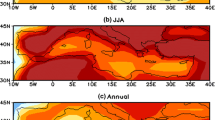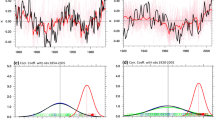Abstract
The roles of anthropogenic climate change and internal climate variability in causing the Mediterranean region’s late 20th Century extended winter drying trend are examined using 19 coupled models from the Intergovernmental Panel on Climate Change Fourth Assessment Report. The observed drying was influenced by the robust positive trend in the North Atlantic Oscillation (NAO) from the 1960s to the 1990s. Model simulations and observations are used to assess the probable relative roles of radiative forcing, and internal variability in explaining the circulation trend that drove much of the precipitation change. Using the multi-model ensemble we assess how well the models can produce multidecadal trends of realistic magnitude, and apply signal-to-noise maximizing EOF analysis to obtain a best estimate of the models’ (mean) sea-level pressure (SLP) and precipitation responses to changes in radiative forcing. The observed SLP and Mediterranean precipitation fields are regressed onto the timeseries associated with the models’ externally forced pattern and the implied linear trends in both fields between 1960 and 1999 are calculated. It is concluded that the radiatively forced trends are a small fraction of the total observed trends. Instead it is argued that the robust trends in the observed NAO and Mediterranean rainfall during this period were largely due to multidecadal internal variability with a small contribution from the external forcing. Differences between the observed and NAO-associated precipitation trends are consistent with those expected as a response to radiative forcing. The radiatively forced trends in circulation and precipitation are expected to strengthen in the current century and this study highlights the importance of their contribution to future precipitation changes in the region.









Similar content being viewed by others
References
Allan R, Ansell T (2006) A new globally complete monthly historical gridded mean sea level pressure dataset (HadSLP2): 1850–2004. J Climate 19(22):5816–5842
Allen MR, Smith LA (1997) Optimal filtering in singular spectrum analysis. Phys Lett A 234(6):419–428
Barnston AG, Livezey RE (1987) Classification, Seasonality and Persistence of Low-Frequency Atmospheric Circulation Patterns. Mon Weather Rev 115(6):1083–1126
Chang P, Saravanan R, Ji L, Hegerl GC (2000) The effect of local sea surface temperatures on atmospheric circulation over the tropical Atlantic sector. J Climate 13(13):2195–2216
Cook E, D’Arrigo R, Mann M (2002) A Well-Verified, Multiproxy Reconstruction of the Winter North Atlantic Oscillation Index since A.D. 1400. J Climate 15:1754–1764
Cullen HM, de Menocal PB (2000) North Atlantic influence on Tigris-Euphrates streamflow. Int J Clim 20(8):853–863
Deser C, Phillips A, Bourdette V, Teng H (2011) Uncertainty in climate change projections: the role of internal variability. Climate Dyn. doi:10.1007/s00382-010-0977-x
Dunkeloh A, Jacobeit J (2003) Circulation dynamics of Mediterranean precipitation variability 1948–98. Int J Clim 23(15):1843–1866
Feldstein SB (2002) The recent trend and variance increase of the annular mode. J Climate 15(1):88–94
Gillett N, Graf H, Osborn T (2003) Climate change and the north Atlantic oscillation. The north Atlantic oscillation: climatic significance and environmental impact. e. a. JW Hurrell, Geophys Mono, 134
Held IM, Soden BJ (2006) Robust responses of the hydrological cycle to global warming. J Climate 19(21):5686–5699
Hoerling MP, Hurrell JW, Xu TY (2001) Tropical origins for recent North Atlantic climate change. Science 292(5514):90–92
Hurrell JW (1995) Decadal trends in the north-atlantic oscillation - regional temperatures and precipitation. Science 269(5224):676–679
Hurrell JW, Kushnir Y, Ottersen G, Visbeck M (2003) An overview of the North Atlantic Oscillation. The North Atlantic Oscillation: climatic significance and environmental impact. e. a. JW Hurrell. Geophys Mono 134:1–35
Hurrell JW, Visbeck M, Busalacchi A, Clarke RA, Delworth TL, Dickson RR, Johns WE, Koltermann KP, Kushnir Y, Marshall D, Mauritzen C, McCartney MS, Piola A, Reason C, Reverdin G, Schott F, Sutton R, Wainer I, Wright D (2006) Atlantic climate variability and predictability: A CLIVAR perspective. J Climate 19(20):5100–5121
Kushnir Y, Robinson WA, Chang P, Robertson AW (2006) The physical basis for predicting Atlantic sector seasonal-to-interannual climate variability. J Climate 19(23):5949–5970
Lu J, Vecchi GA, Reichler TA (2007) Expansion of the Hadley cell under global warming. Geophys Res Lett, 34(6). doi:10.1029/2006GL028443
Mariotti A (2010) Recent changes in ghe mediterranean water cycle: a pathway toward long-term regional hydroclimatic change? J Climate 23(6):1513–1525. doi:10.1175/2009JCLI3251.1
Mariotti A, Dell’Aquila A (2011) Decadal climate variability in the Mediterranean region: roles of large-scale forcings and regional processes. Climate Dyn. doi:10.1007/s00382-011-1056-7
Mariotti A, Zeng N, Yoon J, Artale V, Navarra A, Alpert P, Li L (2008) Mediterranean water cycle changes: transition to drier 21st century conditions in observations and CMIP3 simulations. Environ Res Lett 3(4). doi:10.1088/1748-9326/3/4/044001
Meehl GA, Covey C, Delworth T, Latif M, McAvaney B, Mitchell JFB, Stouffer RJ, Taylor KE (2007) The WCRP CMIP3 multimodel dataset—a new era in climate change research. B Am Meteorol Soc 88(9):1383–1394
Nakicenovic N, Swart R (2000) Special report on emissions scenarios. Cambridge University Press, Cambridge
Osborn TJ (2004) Simulating the winter North Atlantic Oscillation: the roles of internal variability and greenhouse gas forcing. Climate Dyn 22(6–7):605–623
Osborn TJ, Briffa KR, Tett SFB, Jones PD, Trigo RM (1999) Evaluation of the North Atlantic Oscillation as simulated by a coupled climate model. Climate Dyn 15(9):685–702
Previdi M, Liepert BG (2007) Annular modes and Hadley cell expansion under global warming. Geophys Res Lett 34(22). doi:10.1029/2007GL031243
Schneider EK, Bengtsson L, Hu ZZ (2003) Forcing of Northern Hemisphere climate trends. J Atmos Sci 60(12):1504–1521
Schneider U, Fuchs T, Meyer-Christoffer A, Rudolf B (2008) Global precipitation analysis products of the GPCC. Global Precipitation Climatology Centre (GPCC), DWD, Internet publication: 1–12
Seager R, Ting MF, Held I, Kushir Y, Lu J, Vecchi G, Huang H, Harnik N, Leetma A, Lau N, Li C, Velez J, Naik N (2007) Model projections of an imminent transition to a more arid climate in southwestern North America. Science 316(5828):1181–1184
Seager R, Naik N, Vecchi GA (2010) Thermodynamic and dynamic mechanisms for large-scale changes in the hydrological cycle in response to global warming. J Climate 23(17):4651–4668
Shindell DT, Miller RL, Schmidt GA, Pandolfo L (1999) Simulation of recent northern winter climate trends by greenhouse-gas forcing. Nature 399(6735):452–455
Solomon S, Qin D, Manning M, Chen Z, Marquis M, Averyt KB, Tignor M, Miller HL (eds.) (2007): IPCC, 2007: climate change 2007: the physical science basis. Contribution of working group I to the fourth assessment report of the intergovernmental panel on climate change
Thompson DWJ, Wallace JM, Hegerl GC (2000) Annular modes in the extratropical circulation. Part II: Trends. J Climate 13(5):1018–1036
Thompson DWJ, Lee S, Baldwin MP (2003) Atmospheric processes governing the Northern Hempisphere Annular Mode/North Atlantic Oscillation. The North Atlantic Oscillation: climatic significance and environmental impact. e. a. J.W. Hurrell. Geophys Mono 134:81–112
Ting MF, Kushnir Y, Seager R, Li CH (2009) Forced and Internal Twentieth-Century SST Trends in the North Atlantic. J Climate 22(6):1469–1481
Venzke S, Allen MR, Sutton RT, Rowell DP (1999) The atmospheric response over the North Atlantic to decadal changes in sea surface temperature. J Climate 12(8):2562–2584
Wu Y, Ting MF, Seager R, Huang H, Cane M (2010) Changes in storm tracks and energy transports in a warmer climate simulated by the GFDL CM2.1 model. Climate Dyn. doi:10.1007/s00382-010-0776-4
Yin JH (2005) A consistent poleward shift of the storm tracks in simulations of 21st century climate. Geophys Res Lett 32(18)
Acknowledgments
The authors would like to thank the reviewers for their detailed and constructive comments, the Global Decadal Hydroclimate group at Lamont and Columbia for their input, and NOAA and NSF for support. This work is supported under the following grants: NSF AGS-1128172, NA10OAR4310137, NSF ATM08-04107, NSF AGS 05-43256 and NOAA NA08OAR4320912.
Author information
Authors and Affiliations
Corresponding author
Additional information
Lamont-Doherty Earth Observatory Contribution Number 7504.
Rights and permissions
About this article
Cite this article
Kelley, C., Ting, M., Seager, R. et al. The relative contributions of radiative forcing and internal climate variability to the late 20th Century winter drying of the Mediterranean region. Clim Dyn 38, 2001–2015 (2012). https://doi.org/10.1007/s00382-011-1221-z
Received:
Accepted:
Published:
Issue Date:
DOI: https://doi.org/10.1007/s00382-011-1221-z




